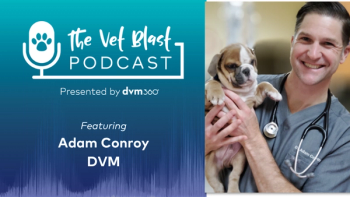
DVM Newsmakers' Summit: Exploring the consumer psyche
DVM Newsmagazine asked five market leaders to talk about consumer attitudes.
Editor's Note: Understanding consumer behavior can help you as a clinician and business manager. DVM Newsmagazine asked five veterinary market leaders to join this year's DVM Newsmakers' Summit at CVC East in Baltimore. Excerpts from the panel discussion will be published over the next three months.
They include: Jim Flanigan, AVMA; Dr. John King, Minnesota state board; Howard Rubin, Brightheart Veterinary Centers; Dr. Richard Timmins, Association for Veterinary Family Practice; Dr. James F. Wilson, consultant and attorney; and DVM Newsmagazine Editor Daniel R. Verdon, moderator.
Verdon: We are entering a fascinating time in the veterinary profession. No other medical profession can boast as great a popularity at a time when veterinary incomes have been simultaneously climbing. But there are challenges when it comes to consumer perceptions and expectations, and that is what we are here to talk about today. The human-animal bond remains the most important market driver, but we should never underestimate the role of the veterinarian in fostering this relationship. I think we are entering a time that will test this bond, especially as it relates to acceptance of advanced care and the costs associated with it. All of this is happening alongside a technological boom that has given veterinary practitioners access to increasingly sophisticated medical tools. So let me pose our first question to our panelists. Are consumer attitudes changing?
Flanigan: More than any other time in the profession's history, we're awash in information about the public's perception of veterinarians. For a very long time, veterinarians went on what their own instincts told them. The relationships they had with their clients informed how they thought the public perceived their profession. But today, we have a lot of wonderful information that supplements those experiences with hard data.
In addition to the AVMA's 2007 edition of the U.S. Pet Ownership & Demographics Sourcebook, which has been done since 1983, we had an animal-health consortium sponsor a study about perceptions and attitudes of pet owners. The study looks at price sensitivities of those pet owners. In addition, the AVMA completed a survey of public perceptions that we've been sharing with veterinary audiences for the last two years. There's even a wealth of information being developed by researchers or funded by entities sometimes unrelated to veterinary medicine, like the Pew Charitable Trust, all of which is being catalogued and shared by the AVMA, NCVEI and other entities within the veterinary profession to help make better decisions.
"We need to be able to explain what it is clients are getting. And we need to empathize with the client about cost."-Richard Timmins, DVM, Association of Veterinary Family Practice
In 2006, we saw an all-time record for the number of owned pets in the United States. In terms of dogs and cats, there are almost 154 million owned in the United States. For cats, that's up 38 percent from 10 years earlier; for dogs, it's up 36 percent from 10 years earlier.
Unfortunately, though, the number of veterinary visits, in spite of the fact that there were almost 181 million visits to the veterinarian in 2006, is down 7 million visits from just five years earlier. So the concern is raised, with the focus on economics over the last five to 10 years, whether veterinarians have "priced themselves out of the market" for veterinary care. What we find is that price is probably not the main driver for the decline in visits. We know overall that 17 percent of the dogs and 36 percent of the cats did not even go to a veterinarian in 2006. And that after reaching a peak in 1996, when 68 percent of all pets did see a veterinarian, that number was down 4 percentage points 10 years later. The mean number of visits is down considerably from 2001 to 2006 — on the order of 10 percent or more.
Veterinary expenditures are up. We spent $23 billion on veterinary care for dogs and cats in 2006. That's an increase of 90 percent for dog-owning households, but only 29 percent for cat-owning households. The question becomes: Has the veterinary profession priced itself out of the market? If this were solely about price, cats would be receiving more care and dogs less, as cats apparently receive more economical care. Think of this another way: Fifty percent of pet owners spent $200 or less per year on veterinary care. Though the number of owners who are spending at the high end — more than $500 — is 22 percent, that means more than three-fourths of all U.S. households spent less than $500 on veterinary care in 2006.
Verdon: Specialty care is another extremely important area of development within this market. Howard Rubin is going to introduce some of the important considerations when it comes to specialty care.
Rubin: As Dan asked me to sit on this panel, he wanted me to focus on two important issues. One being, of course, the idea surrounding the advancing growth in specialty medicine. I'm CEO of BrightHeart Veterinary Centers. We focus strictly on specialty and emergency veterinary practices. We own six of them across the country.
"When we talk about changing public perception of veterinarians, we need to make it clear that any changes that are happening are from a position of strength." - Jim Flanigan, AVMA
I wanted to add a couple points about consumer attitudes and things we found about issues that Jim Flanigan just mentioned. In my former life, I was CEO of the National Commission of Veterinary Economic Issues (NCVEI). We spent a lot of time at NCVEI trying to understand this whole notion of value and how veterinarians can articulate those values most effectively. We learned some very interesting things through focus groups, studies and reports about how veterinarians were dealing with issues surrounding what people will or will not pay for veterinary services.
One of the things we learned was that veterinarians need to talk to pet owners about the steps involved with recommended services. We found also that veterinarians often don't do the kind of work that needs to be done to educate the client about all these steps. When clients balk about fees, they often don't understand everything that is going into it.
At NCVEI, we did some focus groups across the country. We wanted to understand how veterinarians responded when a client said, "Gee, Doc, that seems like a lot of money." We took a simple example and tested this with 90 veterinarians across the country and just over 100 pet owners in eight different focus groups. We took a two-view X-ray and priced it at the national average, which is about $150. We went to the veterinarians and asked how they would respond when a client is concerned about cost.
Much to our chagrin, 50 percent of the veterinarians said that the first thing they do is reduce the price.
That's a pretty telling piece of information. We went to pet owners and asked the same question. What they said overwhelmingly was that they had no real understanding of what goes into taking an X-ray of a companion animal.
What we also found was that those practices in the upper economic quartile were explaining the process to Mrs. Jones. "To take this X-ray, we sometimes need to sedate Rover. We have to get him prepared to take that film; we need to process the film; and then I need to go ahead and analyze the film to determine what we need to be doing to take care of Rover's condition." Overwhelmingly, the pet owners in the focus group said, "We had no idea that it was so involved."
The headline message in all of this is the value to veterinary medicine in spending time explaining the various steps that go into all the things veterinarians do to take care of patients. Overwhelmingly, we know that people want to do the right thing, regardless of the economics.
The next thing I wanted to mention is what's going on in specialty medicine in particular. That's clearly a focus of mine in my current role. Overwhelmingly what we see at BrightHeart, but others report it as well, is that specialty medicine is growing at extraordinarily rapid rates across the United States. The typical specialty veterinary practice is growing at a rate of 20 percent to 25 percent annually. What this really reflects is the willingness and eagerness of pet owners to do the best they can for the companion animal. We see average transaction fees at the general practice level anywhere from $150 to $200. In a multidisciplinary specialty center, they're anywhere from $1,500 to $2,500 on average. It becomes even more important for those involved in specialty medicine to articulate the steps of care to clients. Especially under tough economic conditions, people want to understand all the steps you need to go into to spend that kind of money.
Verdon: So, what do the rest of the panelists think? Are consumer attitudes changing toward veterinary medicine? Dr. Wilson, your thoughts?
Wilson: I believe that attitudes are changing, and so are expectations. People now have friends whose animals have been through specialty-care centers, emergency clinics. They're also becoming aware of when they're not offered those kinds of options or are not accommodated with respect to that level of care. That's when they become disgruntled clients. These clients are struggling. They are those who are looking for some kind of recourse or voice against veterinarians. As a result, the courts don't work very well for them because the pets are still property. And as property, there are minimal damages that one can gain from pursuing a legal course of action. That leads us right to the state boards. Complaining to a state board doesn't cost the client anything. But it puts pressure on the boards.
King: As far as consumer expectations go, there are two consumer groups. One group has increasing expectations about the care they want for their animal, and the other is looking for basic bottom-tier care. Cost is the overriding factor. Consumers want the best care for their animals. Those consumers want options, and they want those opportunities. They have high expectations of success. When those things do not happen, it usually precipitates a complaint to the board of veterinary medicine, because, as Dr. Wilson said, the legal process in the courts of recouping or penalizing or getting satisfaction is not going to meet the needs of the consumer.
Wilson: What percentage of your complaints come from a much higher level of care vs. how many complaints are from that lower tier? That's the tier we often forget about in terms of how much people will spend.
King: We're seeing more complaints from the consumer who has high expectations, wants high-quality medicine and has high expectations to go along with it. Communication between veterinarian and the client is paramount. If that falls through or is not complete, that's what brings on a complaint.
Flanigan: When we talk about changing public perception of veterinarians, we need to make clear that any changes that are happening are from a position of strength for veterinarians. The public adores veterinarians. The fact that Gallup only includes veterinarians once every three years in a poll for the professions that are most trusted for their honesty and ethics is a testament to that. Veterinarians skew the curve. Every survey that's done that pits veterinarians against other professions shows that veterinarians are well respected and are key influencers over decisions people make for their pets and farm animals. Whether or not veterinarians believe it, they are key influencers in public policy and animal-welfare issues.
Rubin: One of the things I'd like to bring up as part of this question about consumer attitudes is this demand for more services and growing public expectations. Some of the negatives are that veterinarians can lag behind the consumer in terms of their willingness to offer and accept advanced care.
How many times have you heard: "Well, do I really need to do this, Doc? Would you do this for your own animal?"
Often veterinarians need to make a choice on the protocol or procedure. What we find often is that veterinarians are going to be held to the highest standard of outcomes, regardless of the medical protocol. If you do a surgical procedure without all the pre-operative work, and there is a negative outcome, the client is not going to be satisfied if you say, "Well, you didn't give me the authority to go ahead and do the blood chemistry or the EKG." They're going to write to the licensing board and say the outcome was not satisfactory. That's all part of it. That all connects to the expectation.
Veterinarians need to understand what's going on in regard to changing attitudes. Clients are demanding more from this profession.
Timmins: Back in early 1991, Dr. Tom Catanzaro reported on a study that he did of military veterinarians and their clients. He was asking the question, "Do veterinarians understand the relationship of the client to their pets?" He asked the clients questions like: "Do you celebrate your pet's birthday? Do you take the pet on vacations?"
He then asked veterinarians what percentage of their clients answered yes to those sorts of questions.
He found that veterinarians, across the board, underestimated the social dependency clients had on their pets. Nearly 20 years later, one of my students wanted to find out if that was still the case or had veterinarians improved in their understanding of that relationship. We did a study in Sacramento of veterinarians and their clients asking those same questions. Veterinarians still underestimated the relationship. You need to be aware of what that relationship is.
Another thing we need to remember for upper-tier clients: They think of pets as part of their families. These individuals are now concerned about their own medical costs. They're going to be extrapolating their concerns to the concerns of medical costs for their pets. The comments Howard made about value propositions are extremely important. We need to be able to explain what it is clients are getting. And we need to empathize with the client about the cost.
Wilson: We talked about this communication gap. In teaching students, I've found that most have a major fear of rejection. This fear frequently drives this communication problem, and the client starts challenging costs. So many younger veterinarians get out there and are afraid to offer options because of this fear of rejection. That's where they run into that communication problem. They're anticipating a negative because there's fear.
King: I agree. There's fear of being rejected. We don't have full opportunity to explain why we're doing it. Those type of things lead to client satisfaction. The vast majority of clients are thrilled with the care they receive from veterinarians. But there are some people who are not happy and need to find a way to express the dissatisfaction.
Rubin: I'd like to expound on the notion of being empathetic about pricing. It's very important. All research shows empathy is a big reason veterinarians are such a highly respected part of communities.
At the same time, we need to understand the layers to have something this expensive. Just because someone believes something is really expensive doesn't mean they're unwilling to spend the money for it. We all know that in our own personal experiences. We take our families to a great meal. We get the bill at the end saying, "Oh my gosh, this was so expensive." In the next moment, we are planning the next event because it was a great experience.
Yes, great veterinary care is costly. But, by explaining the steps and having people understand what it takes to deliver that kind of care doesn't mean they're unwilling to spend the money.
Flanigan: The average consumer spent $356 on veterinary care in 2006 according to the U.S. Pet Ownership & Demographic Sourcebook. That's not a lot of money, especially when you consider that, according to the Bureau of Labor Statistics, the average household spent $143 on women's shoes, $400 on beer and alcohol; $43 on gambling losses; $550 on personal-care products and services (such as fixing their hair). They spent $2,600 per household on their own medical care. The $356 on veterinary care is not very expensive, especially when you consider the relationship between veterinarians and clients and the services provided to their pets. The most price-sensitive person in that relationship is the veterinarian, not the consumer.
Newsletter
From exam room tips to practice management insights, get trusted veterinary news delivered straight to your inbox—subscribe to dvm360.






